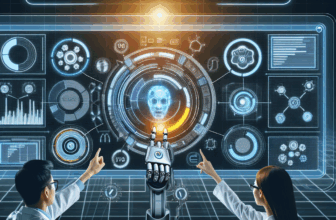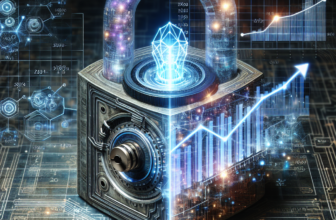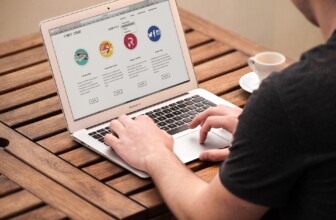Revolutionizing Web Design: The Benefits of AI-Driven Automated Website Creation
Table of Contents
- Introduction: The Emergence of AI in Web Design
- Understanding AI-Driven Automation
- Benefits of AI-Driven Automated Website Creation
- Real-Life Case Studies of AI in Web Design
- Challenges and Limitations of AI in Web Design
- 5.1 Quality Concerns
- 5.2 Dependency on Algorithms
- 5.3 User Acceptance
- Future Trends in AI-Driven Web Design
- Frequently Asked Questions (FAQ)
- Resources
- Conclusion
- Disclaimer
Introduction: The Emergence of AI in Web Design
The digital landscape has transformed remarkably over the past few decades, evolving from static pages to dynamic, interactive websites. The advent of artificial intelligence (AI) marks the pinnacle of this evolution, introducing new methodologies and tools that streamline and enhance the web design process. AI-driven automated website creation is revolutionizing the industry by enabling faster, more efficient, and customized solutions that cater to users' specific needs.
In this article, we will delve into the intricate details of AI-driven automated web design, exploring its benefits, real-world applications, challenges, and future implications. The objective is to provide a comprehensive understanding of how AI reshapes the web design arena and the potential it holds for businesses seeking to establish a formidable online presence.
Understanding AI-Driven Automation
What is AI-Driven Automation?
AI-driven automation involves the integration of artificial intelligence technologies into the web design process to facilitate automated tasks that traditionally required human intervention. This can include everything from content creation and layout design to user experience personalization and SEO optimization. As a result, businesses can streamline operations, reduce human error, and maintain a high level of quality across their digital platforms.
How AI Algorithms Work
AI algorithms operate based on data input and predefined parameters that allow machine learning, natural language processing, and other AI technologies to enhance or automate tasks. Key processes involved in AI-driven automation include:
- Data Collection: AI systems gather extensive data from various sources — user interactions, market trends, and competitor analysis.
- Machine Learning: Algorithms learn from the collected data and discern patterns that can guide design choices, aiding in decision-making.
- Natural Language Processing (NLP): NLP enables AI to understand and generate human language, which can be utilized in chatbots, content generation, and user feedback analysis.
AI algorithms can adapt over time based on new data and user interactions, making them highly efficient tools in web design.
Benefits of AI-Driven Automated Website Creation
Speed and Efficiency
AI significantly enhances the speed and efficiency of website creation. Traditional web design processes can be resource-intensive, involving lengthy phases of planning, development, and iteration. In contrast, AI-driven tools can generate websites in a fraction of the time. For example, an AI tool can rapidly evaluate user requirements and preferences, enabling it to design a tailored website layout almost instantaneously.
Moreover, AI-driven automation reduces the need for multiple revisions and refinements, as algorithms can learn from user feedback and automatically adjust designs accordingly. This acceleration in web design timelines allows businesses to launch their online presence more swiftly, keeping pace with ever-evolving market dynamics.
Cost Reduction
Implementing AI-driven automated web creation tools can lead to substantial cost savings for businesses. Traditionally, hiring a team of designers, developers, and content creators can be financially burdensome. AI reduces these costs by automating many of the tasks performed by human teams. For small businesses and startups with limited budgets, this can be a game-changer, allowing access to high-quality web design without breaking the bank.
Furthermore, AI tools often come with subscription-based pricing models or pay-as-you-go options, making them flexible financial solutions.
Personalization and User Experience
One of the most remarkable benefits of AI in web design is its ability to enhance user experience through personalization. AI algorithms analyze user data to understand individual preferences and behaviors, enabling businesses to deliver tailored content, recommendations, and interfaces.
For instance, e-commerce websites can use AI to personalize product recommendations based on a user's past browsing history and buying patterns. This not only improves user satisfaction but can lead to increased conversion rates as users are more likely to engage with content that resonates with them.
Scalability
AI-driven automated website creation allows businesses to scale their digital platforms with remarkable ease. As companies grow, their web presence must adapt to accommodate increasing traffic, additional content, and new functionalities. Traditional web design structures can struggle to scale efficiently under these conditions.
Conversely, AI tools can quickly adjust website components and layouts, ensuring that as a business expands, its website remains functional and appealing. This scalability can significantly enhance a company's ability to grow and compete effectively.
Real-Life Case Studies of AI in Web Design
Case Study: Wix ADI
Wix, a leading website builder, introduced its Artificial Design Intelligence (ADI) tool to simplify the website creation process for users with limited technical expertise. Wix ADI asks users specific questions about their preferences, such as the type of website they want to create, desired features, and design styles.
Based on the responses, ADI generates a fully functional website in minutes, complete with personalized content and images. This capability illustrates how AI can drastically reduce the time required to create a professional-looking website, democratizing access to digital tools for small business owners and entrepreneurs.
Case Study: Bookmark's AIDA
Bookmark is another website builder that leverages AI through its tool, AIDA (Artificial Intelligence Design Assistant). AIDA guides users through the web creation process by asking about their objectives and preferred styles.
Upon receiving input, AIDA crafts a customized website based on over a million design combinations from its AI database. The website can be edited and adjusted in real-time, highlighting the collaborative potential between AI technology and human creativity. Bookmark's AIDA demonstrates the efficiency and customization that AI can bring to the web design process.
Challenges and Limitations of AI in Web Design
Quality Concerns
Despite its numerous advantages, the quality of AI-generated websites can often fall short of human-produced designs. AI systems rely heavily on existing data and algorithms, and if the quality of this input is compromised, it can lead to poorly designed websites.
Moreover, while AI can generate visually appealing layouts, it may lack the nuanced understanding of branding, aesthetics, and emotional connection that human designers bring to the table. Businesses must weigh the cost-benefit trade-off when utilizing AI tools, as the final product may require additional human oversight to ensure quality.
Dependency on Algorithms
Heavy reliance on AI algorithms can lead to unintended biases and limitations in design choices. Algorithms are fundamentally shaped by the data they are trained on, and if this data has inherent biases or shortcomings, the resulting designs may reflect these issues.
Furthermore, when businesses become too dependent on AI systems, they may lose the ability to think creatively and innovate in their designs. Maintaining a balance between human creativity and AI efficiency is essential to avoiding these pitfalls.
User Acceptance
The acceptance of AI-driven automated web design tools among users varies significantly. Some individuals may embrace the technology as a solution to streamline their business processes, while others may prefer the personalized touch that comes from working with human designers.
Educating users about the benefits and capabilities of AI-driven tools can help bridge this gap. Demonstrating the value of AI in improving efficiency and user experience reduces resistance and encourages wider adoption.
Future Trends in AI-Driven Web Design
Advancements in Natural Language Processing
Natural Language Processing (NLP) continues to evolve, paving the way for more sophisticated interaction between users and AI-driven web design tools. Future AI applications may enable users to converse with design tools in natural language, streamlining the input process and allowing for a more intuitive creative environment.
For instance, a user could verbally express their ideas and preferences to an AI, which would translate those into actionable design elements, creating a more user-friendly and engaging experience.
More Intelligent AI Systems
As AI technology matures, we can expect to see more intelligent systems that take into account broader contextual factors in web design. Future AI tools may incorporate elements such as emotional intelligence, cultural considerations, and user psychology to deliver more empathetic and tailored experiences.
Innovative features like these could redefine how users interact with digital content, making it more engaging and meaningful.
Frequently Asked Questions (FAQ)
Q1: Can AI replace human web designers entirely?
While AI can significantly enhance the web design process, it is unlikely to replace human designers entirely. AI excels in automating repetitive tasks and analyzing data, but human creativity, intuition, and emotional intelligence are irreplaceable assets in crafting compelling web experiences.
Q2: What industries can benefit most from AI in web design?
Virtually every industry can benefit from AI-driven web design, including e-commerce, education, healthcare, and entertainment. Each sector can apply AI tools in unique ways to enhance user experience, optimize conversions, and streamline design processes.
Q3: How can small businesses afford AI-driven web design tools?
Many AI-driven website creation tools, like Wix and Bookmark, offer flexible pricing options, including free tiers or affordable subscriptions. This accessibility allows small businesses to leverage AI technology without incurring significant costs.
Q4: Will AI-generated websites be unique?
While AI can create personalized designs, there is a possibility of similarities between AI-generated websites, particularly if multiple users rely on the same tool. Continuous innovation in AI algorithms and user input will be essential to maintain diversity in web designs.
Resources
| Source | Description | Link |
|---|---|---|
| Wix | Website builder leveraging AI for automated web design | Wix |
| Bookmark | AI-driven website builder with AIDA | Bookmark |
| Adobe | Provides insights on AI in design and technology | Adobe |
| Smashing Magazine | Articles on web design trends and techniques | Smashing Magazine |
| HubSpot | Resources on digital marketing and design | HubSpot |
Conclusion
The integration of AI in web design heralds a new era grappling with a fusion of creativity and technology. Through the benefits of speed, cost reduction, personalization, and scalability, AI-driven automated website creation empowers businesses to enhance their digital presence and foster a responsive user experience.
However, it is essential to acknowledge the challenges and limitations that accompany this technology, such as quality concerns, algorithm biases, and user acceptance. As we move towards a future enriched by continuous advances in AI, the landscape of web design will increasingly evolve.
For businesses and designers, staying abreast of these advancements will be critical, offering countless opportunities to innovate and redefine the way we approach digital design.
Disclaimer
This article is produced by A.I. and is in Beta Testing. The information provided within is for informational purposes only and should be used as a guide for understanding AI-driven automated website creation's advantages, challenges, and trends. Always consult professionals for specific advice or deeper inquiries into web design projects.
This article has provided a comprehensive overview and in-depth exploration of AI-driven automated website creation, aiming to equip readers with valuable insights for navigating this transforming domain of web design.










